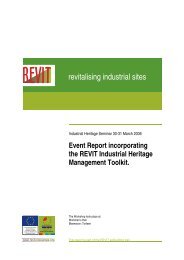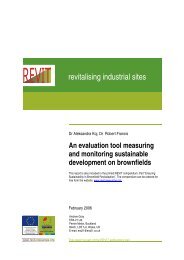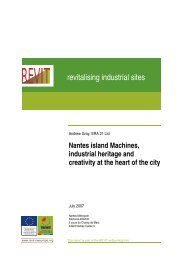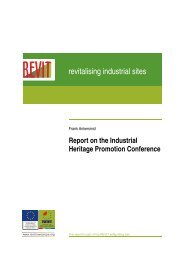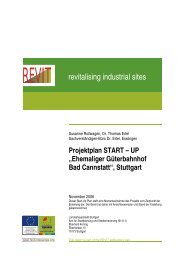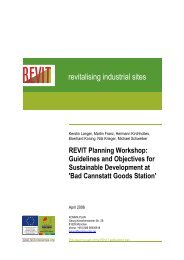REVIT Heritage Report.pdf
REVIT Heritage Report.pdf
REVIT Heritage Report.pdf
You also want an ePaper? Increase the reach of your titles
YUMPU automatically turns print PDFs into web optimized ePapers that Google loves.
Torfaen County Borough Council<br />
<strong>REVIT</strong>: A Review of the Conservation of Industrial <strong>Heritage</strong> Assets on Brownfield Sites<br />
4.4 Nantes<br />
Île de Nantes Project<br />
4.4.1 Nantes, which forms part of the region of Pays de la Loire and the Loire-<br />
Atlantique department, one of the most industrialised in France. The dominant<br />
industries in the area included shipbuilding, metalworking, food industries, the<br />
production of chemicals and sugar and tobacco importing.<br />
4.4.2 The Île de Nantes project consists of the regeneration of 350 hectares of<br />
Brownfield land on an island within the Loire. The Nantes Island, which<br />
currently accommodates approximately 13,000 inhabitants and employment for<br />
9,000 people, encompasses many hectares of land and public spaces which<br />
are often inadequately used or derelict.<br />
4.4.3 The Communauté Urbaine de Nantes together with the support of SAMOA<br />
(Société d’Aménagement de la Métropole Ouest Atlantique), is promoting the<br />
Île de Nantes project. The scheme commenced in 2001 with a partnership of<br />
the State, the Area and the Department, the Port Authority and SNCF. The<br />
first work started in October 2002.<br />
4.4.4 The project aims to bring the area into the metropolitan district through<br />
improving the quality of life, economic development, trade, collective transport,<br />
social and cultural development and leisure pursuits. The project master-plan<br />
includes integrated policies on culture, tourism, the industrial heritage as well<br />
as the proposed architectural design standards. The design and materials of<br />
all new housing developments along the banks of the Loire are being<br />
controlled so that they harmonise with the historic setting.<br />
4.4.5 The backbone of the plan is an axis of East-West public spaces which will be<br />
arranged to connect the various districts of the island. In addition the relocation<br />
of the present railway transport system on the island is an important element in<br />
long term project. This will allow the regeneration of 30 hectares of land under<br />
the control of RFF/SNCF after having moved associated activities. To link the<br />
area to the town centre a pedestrian footbridge is under construction to the<br />
island, over the Loire.<br />
4.4.6 The regeneration project is an example of Cultural Planning which has rejected<br />
traditional planning zones in favour of retaining the area’s diverse character.<br />
The goal of the regeneration is to gradually establish a mixed-use development<br />
for the area by transforming the many derelict industrial buildings and spaces<br />
at the same time conserving and repairing historic industrial buildings for reuse<br />
wherever possible; demolition is seen as a last resort. The industrial<br />
features of the island are considered important and have been integrated into<br />
the project to retain the diversity of the urban landscape.<br />
4.4.7 Since the second half of the 19 th century, the island of Nantes has played an<br />
essential role in the local economy by allowing the expansion of industries<br />
which could not a location on the northern bank of the Loire.<br />
4.4.8 The diverse area consists principally of:<br />
• the old suburb around a historical axis of the North-South crossing of the<br />
Loire;<br />
• an industrial-harbour zone in the Western part (Prairie au Duc and Sainte-<br />
Anne Island) with many derelict industrial areas which with date from the<br />
mid-19 th century; and<br />
0014021/JM/001 29




